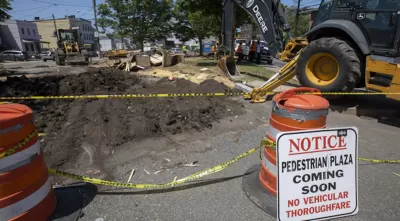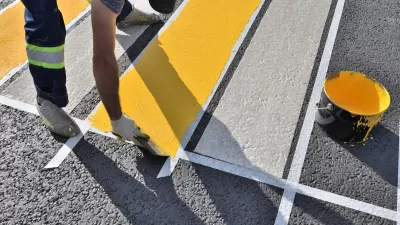The city’s new Department of Infrastructure consolidates the management of public amenities and has guided the creation of new bike lanes, pedestrian plazas, and parks.

The decision to consolidate the management of streets, transit, parks, municipal buildings, and other public facilities into one Department of Infrastructure in Jersey City, New Jersey has made a significant impact on the city’s public realm, writes Robert Steuteville in Public Square.
The consolidation has helped the city understand its transportation and mobility needs and resources from a broader perspective. “The department and policies leading up to its creation were pivotal in implementing nearly 25 miles of protected bike lanes, carving pedestrian plazas from excess asphalt, planting more than 1,000 trees, building new parks, renovating public spaces, and creating parklets for outdoor dining.”
The rapid changes are also due to the city’s embrace of tactical urbanism strategies — quick-build, low-cost interventions usually implemented by local activists that skirt traditional bureaucratic processes. In the case of Jersey City, the city itself adopted the concept to deploy nimble, low-cost projects that have led to permanent changes. “Leftover tennis court paint and planters were used to build a pedestrian plaza through the heart of the downtown dating from the 17th Century. Road diets were implemented along major streets to establish the protected bike lane network using paint and vertical separation. The nimble fleet of micro-transit vans was employed to fill gaps in transit access.” In 2022, the city eliminated traffic deaths for a full year on city-managed roads thanks in large part to quick-build road safety interventions.
For Steuteville, Jersey City is a prime example of what can happen when a city takes a holistic view of infrastructure and rejects bureaucracy in favor of immediate — and sometimes life-saving — improvements to the public realm.
FULL STORY: Infrastructure Department boosts the public realm

Alabama: Trump Terminates Settlements for Black Communities Harmed By Raw Sewage
Trump deemed the landmark civil rights agreement “illegal DEI and environmental justice policy.”

Planetizen Federal Action Tracker
A weekly monitor of how Trump’s orders and actions are impacting planners and planning in America.

Why Should We Subsidize Public Transportation?
Many public transit agencies face financial stress due to rising costs, declining fare revenue, and declining subsidies. Transit advocates must provide a strong business case for increasing public transit funding.

How Housing as a Financial Product Harms Communities
Institutional buyers who treat housing as an investment product become disconnected from the impacts of higher rents, displacement, and housing instability.

Blinded by the Light: When Brighter Headlights Decrease Safety
Bright LED headlights can create glare and reduce visibility for other drivers and pedestrians.

Study Links Covid and Poor Driving
The effects of the virus, including ‘brain fog,’ can make driving more difficult and dangerous.
Urban Design for Planners 1: Software Tools
This six-course series explores essential urban design concepts using open source software and equips planners with the tools they need to participate fully in the urban design process.
Planning for Universal Design
Learn the tools for implementing Universal Design in planning regulations.
Caltrans
Smith Gee Studio
Institute for Housing and Urban Development Studies (IHS)
City of Grandview
Harvard GSD Executive Education
Toledo-Lucas County Plan Commissions
Salt Lake City
NYU Wagner Graduate School of Public Service





























